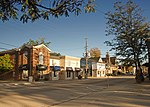Elmira, Ontario
Communities in the Regional Municipality of WaterlooUse Canadian English from January 2023Woolwich, Ontario

Elmira is the largest community in the township of Woolwich, Ontario, Canada. It is 15 kilometres (9 mi) north of the city of Waterloo near the Regional Municipality of Waterloo's northern border with Wellington County. The community was listed in the 2016 Canadian census as having a population of 10,161.Waterloo Region is home to the largest population of Old Order Mennonites in Canada, particularly around St Jacobs and Elmira. They are often seen on the local roads using traditional horse and buggy transportation; many also use horses to pull the implements in their farm fields.
Excerpt from the Wikipedia article Elmira, Ontario (License: CC BY-SA 3.0, Authors, Images).Elmira, Ontario
University Avenue West, Woolwich
Geographical coordinates (GPS) Address Phone number Website Nearby Places Show on map
Geographical coordinates (GPS)
| Latitude | Longitude |
|---|---|
| N 43.593333333333 ° | E -80.5625 ° |
Address
Elmira District Secondary School
University Avenue West 4
N3B 1K2 Woolwich
Ontario, Canada
Open on Google Maps








